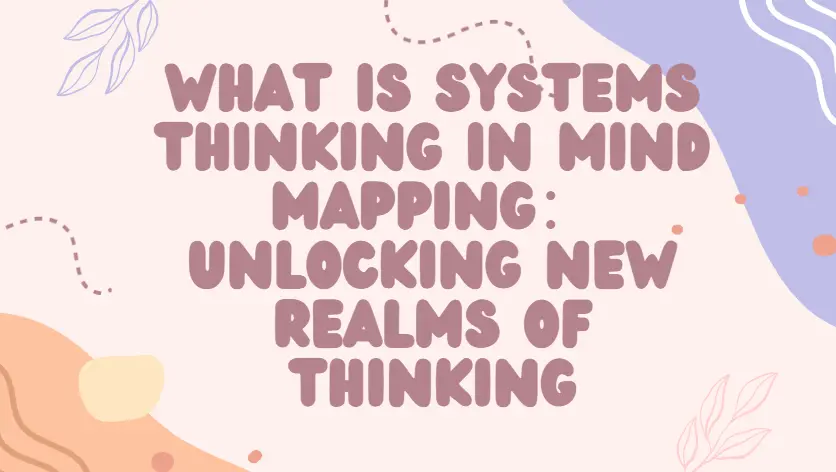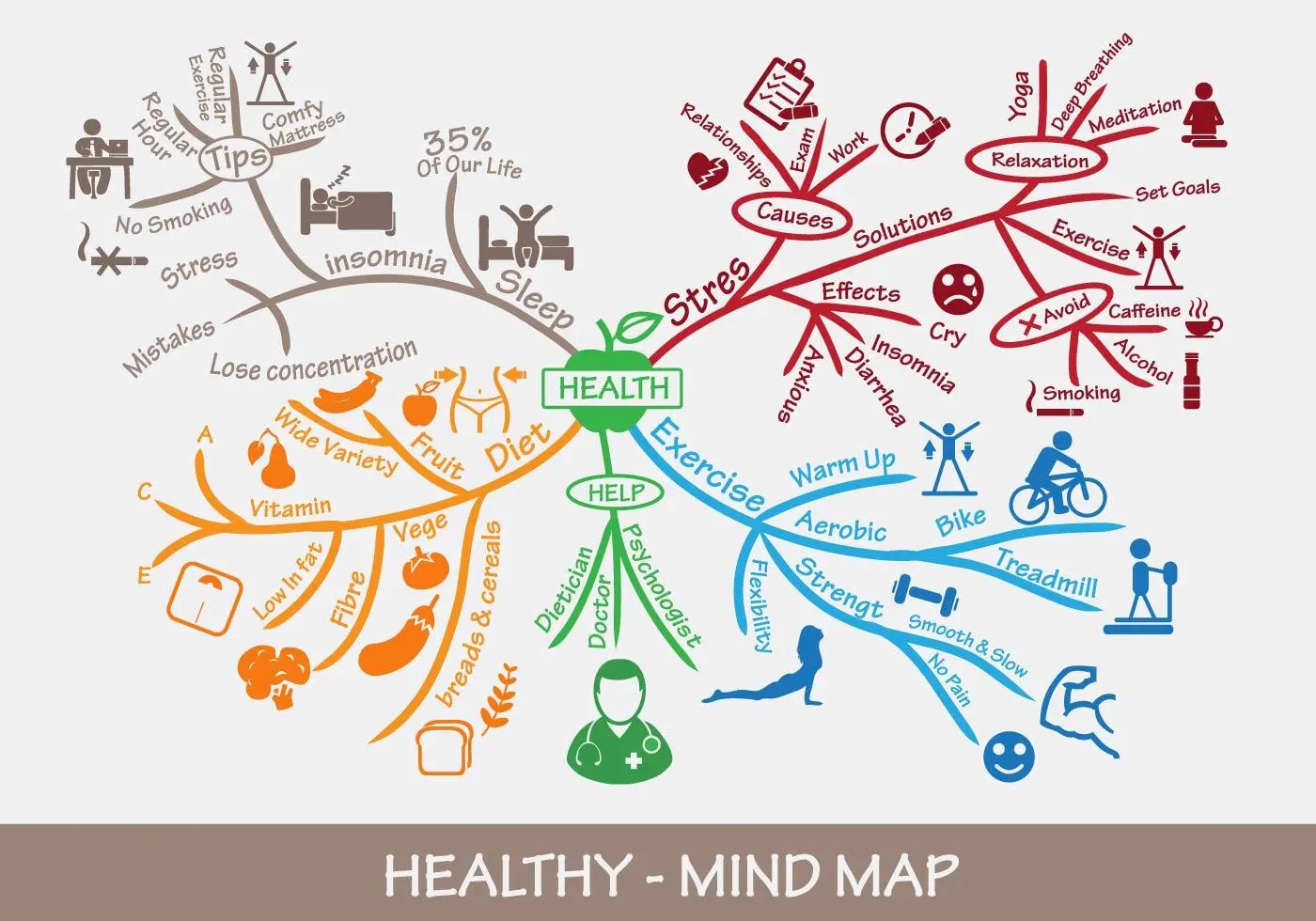At the intersection of cognitive science and organisational behaviour, Mind Mapping, as a visual thinking tool, has become an important means of promoting knowledge integration, innovative thinking and efficient communication by virtue of its intuitive, hierarchical and associative nature. It simulates the natural thinking process of the human brain by taking complex information with a central theme as the core and radiating branches and associated nodes in all directions.
1.The integration of systems thinking into Thinking Maps
Systems Thinking, as an interdisciplinary methodology, emphasizes the examination of problems from a holistic and dynamic perspective, and the identification and understanding of the interactions, feedback mechanisms, and overall behavioral patterns of various components within a system. In the modern complex and changing social environment, Systems Thinking has an irreplaceable role in solving cross-disciplinary and multi-level problems and making long-term and sustainable decisions.
The integration of systems thinking into Thinking Maps is not only a profound expansion of the application of traditional Thinking Maps, but also a significant enhancement of the effectiveness of thinking tools. This integration aims to build a more comprehensive, dynamic and interrelated thinking model to help individuals or teams to more accurately grasp the essence of the problem in front of complex problems and foresee the potential trend of change, so as to formulate more scientific, reasonable and forward-looking solutions and decision-making strategies. Therefore, exploring the application of systematic thinking in Thinking Maps is of great significance to improve the thinking ability and decision-making level of individuals and organizations.
2.Foundations of Systems Thinking
As an advanced cognitive methodology, Systems Thinking aims to reveal and analyze the interdependencies, interactions, and dynamically evolving relationships among elements within a system. It emphasizes a holistic perspective, recognizing that the overall performance of a system cannot be reduced to the sum of the attributes of its individual parts, but rather is determined by the complex interrelationships and interactions among those parts.
The core principles of systems thinking include, but are not limited to, the following:
- First, feedback loops reveal the cyclical relationship between actions and outcomes within a system, which can be either positive feedback leading to a deviation from equilibrium or negative feedback promoting system stability;
- Second, dynamic equilibrium emphasizes the system’s ability to maintain or seek a certain steady state in the face of both internal adjustments and external perturbations; and, further, nonlinear relationships point out that systems Furthermore, the non-linear relationship points out that the role of internal elements is not always a linear proportional relationship, and small changes may trigger significant effects, the so-called “butterfly effect”.
Because of its powerful explanatory and predictive power, systems thinking has shown extensive application value in many disciplines.
- In project management: systems thinking helps managers to identify critical paths, risk sources and dependencies in a project, and to achieve optimal control of the project and efficient allocation of resources.
- In organizational development: it promotes a comprehensive review and reconstruction of organizational structure, processes and culture, and promotes continuous innovation and change of the organization
- In the field of environmental science: systems thinking has become an important tool for studying ecosystems, climate change and other complex environmental issues, which helps to formulate more scientific environmental protection policies and strategies.

Image from: Medium
3.Mind Mapping Overview
Mind Mapping, as a knowledge visualization technique, is centered on showing the divergent and hierarchical nature of thinking in a graphical way. Its concept can be traced back to the 1960s, and was pioneered by British scholar Tony Buzan, aiming to mimic the brain’s natural thinking mode and enhance learning efficiency and creativity. Buzan’s contribution lies not only in proposing this innovative thinking tool, but also in the fact that through extensive research and promotion, Mind Mapping has been widely used in many fields, such as education, business management and personal growth.
The construction of a mind map is based on a series of well-designed elements, which together form its unique visual structure.
- First of all, the central theme as the starting point of thinking, clear thinking activities of the core issues; around the central theme to develop the branches, on behalf of the different dimensions or sub-topics associated with the theme, these branches can be further refined into more specific keywords, so as to facilitate the precise positioning of information and memory.
- In addition, images and colors are used as auxiliary elements to enhance the attractiveness and memorability of mind maps through visual stimulation, making the information more vivid and easy to understand.
Thinking Maps show significant advantages in improving individual cognitive ability and work efficiency.
- It effectively promotes the memory retention and recall of information through intuitive graphical presentation, allowing complex concepts and knowledge systems to form a solid memory network in the brain.
- Mind mapping encourages the dispersion and jumping of thinking, providing fertile soil for creative generation, helping to break the stereotypes of thinking and stimulating new ideas and solutions.
- Finally, in terms of information organization and management, Mind Maps, with their clear hierarchical structure and logical relationships, help users quickly sort out and integrate a large amount of information, improving the efficiency and accuracy of information processing.

Image from: nchsoftware.com
4.The application of system thinking in mind mapping
Constructing a systems perspective: under the guidance of systems thinking, transforming the mind map into a systems analysis tool requires us to pay attention not only to the hierarchy and categorization of the information in the process of drawing, but also to explore the structural relationships and dynamic characteristics behind the information in depth. Specifically, this process involves the following key steps:
- Identify the key elements. At the initial stage of the construction of the system mind map, it is necessary to carefully identify the core elements or entities within the system, which are often the key factors affecting the overall performance and behavior of the system. By using them as the central theme or first-level branches, the foundation is laid for the subsequent construction of the relationship chain.
- Draw the relationship chain. The drawing of the relationship chain is the core link in the construction of the system model, which requires us to apply the principles of cause and effect logic and interdependence in system thinking, and visualize the interactions, influence paths, and dependencies among the key elements in the form of branches and connecting lines. This step not only helps to reveal the complex network of relationships within the system, but also provides a clear framework for subsequent analysis and decision-making.
- Finally, the feedback mechanism is introduced. Feedback is an important manifestation of the dynamic characteristics of the system, which describes the impact of changes in the internal state of the system on subsequent behavior. In the system mind map, we can draw positive and negative feedback loops to show the stable or unstable state that the system may present under different conditions. This process not only deepens our understanding of the dynamic behavior of the system, but also provides strong support for developing intervention strategies to achieve system optimization.

Image from: slideteam.net
5.Practice Guide:Step-by-Step!
In the practice of incorporating systems thinking into the creation of mind maps, it is crucial to follow a systematic set of steps.
- First, clarify the central theme, i.e., identify the core topic or goal of the systems analysis, which is the logical starting point for the entire mind map. Subsequently, system elements are comprehensively identified, including key variables, entities and their attributes, to ensure that important components within the system are covered without omission.
- Next, a relationship diagram is carefully drawn, using visual elements such as arrows and symbols to clearly demonstrate the interactions, cause-and-effect chains, and feedback mechanisms between the elements, and to construct a dynamic model of the system.
- In addition, as the analysis progresses, the structure and content of the mind map may need to be iteratively adjusted to more accurately reflect the complexity and dynamics of the system.
Common Misconceptions and Avoidance Strategies:
In practice, several common misconceptions need to be guarded against.
One is oversimplification, i.e., focusing only on the direct connections on the surface of the system, while ignoring the indirect effects and potential variables at the deeper level. In order to avoid this misunderstanding, we should uphold the principles of comprehensiveness and depth, collect as much information as possible, and conduct in-depth analysis using the methodology of systems thinking.
Second, feedback is neglected, i.e., the feedback mechanism within the system is not adequately identified and considered, leading to biased prediction and intervention of the dynamic behavior of the system.
To overcome this problem, special attention should be paid to the positive and negative feedback loops in the system, and corresponding regulation strategies should be formulated accordingly. In addition, we should avoid blindly applying templates and flexibly design the structure and content of mind maps according to the characteristics and needs of specific problems.
Continuous learning and optimization:
As an advanced cognitive tool and methodology, Systems Thinking and Thinking Maps cannot be applied without continuous learning and practicing to improve their ability and effectiveness.
Therefore, readers are encouraged to keep an open mind, actively absorb new knowledge and skills, and continuously broaden their horizons and thinking boundaries.
At the same time, they should develop the habit of reflection and iteration, regularly review their own systematic mind map creation process, summarize the lessons learned, and continuously optimize the thinking model and analysis methods. Through this cycle, you can gradually improve your systematic thinking ability and mind map creation level.

Image from:Continuous Learning In The Workplace - Sertifier
6.Conclusion and Outlook
This blog discusses the core value and application potential of systems thinking in mind mapping, revealing its significant advantages in facilitating the analysis of complex problems, optimizing the decision-making process, and enhancing innovative thinking. By building a systems perspective, mind mapping has not only become an efficient information organization and visualization tool, but also evolved into an important platform for understanding and analyzing the dynamic behavior of systems. The introduction of systematic thinking makes Mind Mapping go beyond the traditional hierarchical structure to reveal the intrinsic connections and interactions between things in a more comprehensive and in-depth way, providing a more solid theoretical foundation and practical guidance for problem solving and strategy development.
We would like to sincerely encourage every reader to start trying to integrate systems thinking into their mind mapping practice. This is not only a skill enhancement, but also a mindset shift. Through continuous learning, practice and reflection, you will be able to become more skillful in applying Systems Thinking to solve real-world problems, and discover new insights and opportunities in the process. At the same time, we also expect you to actively share your experience and results, and explore the infinite possibilities of Systems Thinking and Mind Mapping with more like-minded people.








